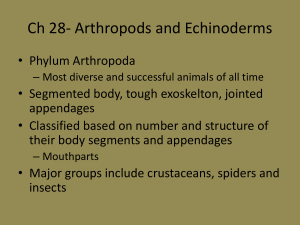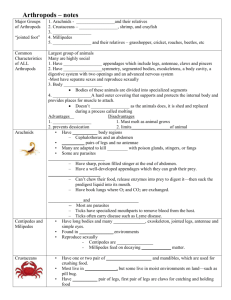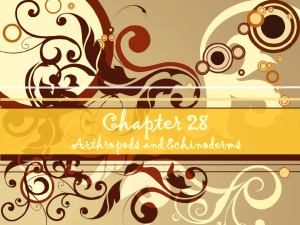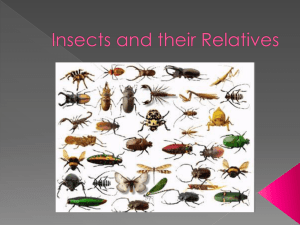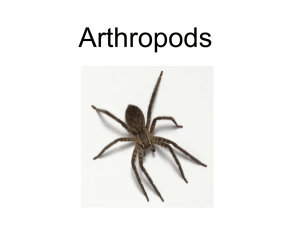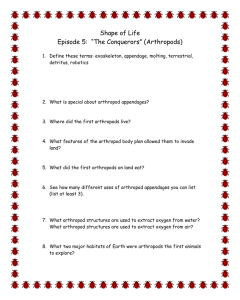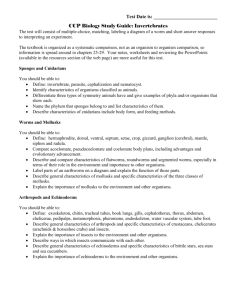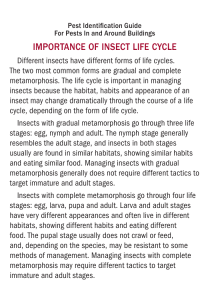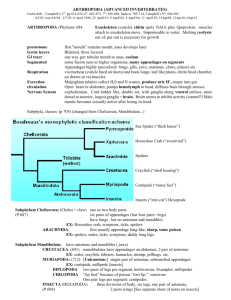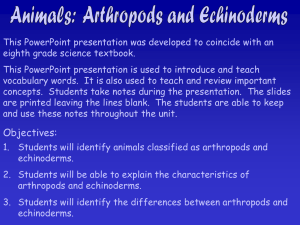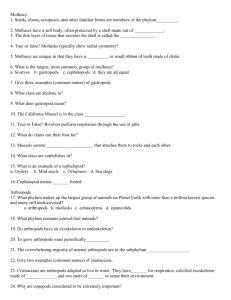Ch 28 - USD305.com
advertisement
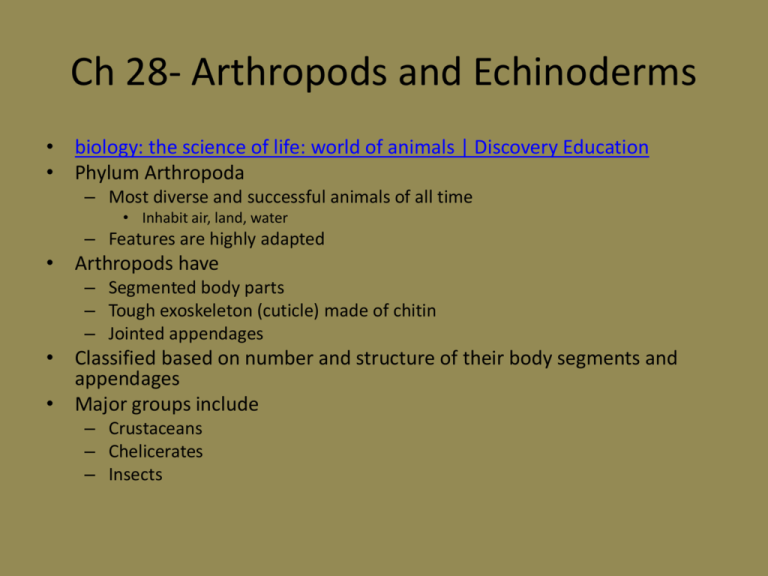
Ch 28- Arthropods and Echinoderms • biology: the science of life: world of animals | Discovery Education • Phylum Arthropoda – Most diverse and successful animals of all time • Inhabit air, land, water – Features are highly adapted • Arthropods have – Segmented body parts – Tough exoskeleton (cuticle) made of chitin – Jointed appendages • Classified based on number and structure of their body segments and appendages • Major groups include – Crustaceans – Chelicerates – Insects Crustaceans • Subphylum Crustacea – Evolved as marine arthropods • Crustaceans share several common features – – – – – Two distinct body sections, cephalothorax and abdomen One pair of appendages per segment Two pairs of antennae Exoskeleton Carapace • Appendages used for variety of functions – Collecting and manipulating food – Attracting females – protection Crustaceans • Crustaceans vary in both anatomy and structure • Types include – Decapods- lobsters and crabs have ten legs; largest group – Barnacles- sessile filter feeders wrapped in hard shell – Isopods- such as pill bugs have flattened bodies and seven pairs of legs – Tongue worms- parasites found in a host’s lungs or nasal passages Chelicerates • There are three major groups of chelicerates – Horseshoe crabs- oldest living arthropods – Sea spiders – Arachnids- spiders, mites, ticks, and scorpions • Chelicerates share several features – No antennae – Four pairs of walking legs – One pair each of chelicerae and pedipalps Arachnids • Arachnids- group of chelicerates that live on land – Eight legs – Fanglike pincers that inject venom – Silk glands Uniramians • Subphylum Uniramia or uniramians – Most species of all animals • Uniramians have – Jaws, one pair of antennae, unbranched appendages • Uniramians include – Centipedes – Millipedes – Insects Insects • What are the distinguishing features of insects? – Body divided into 3 parts- head, thorax, and abdomen – 3 pairs of legs attached to thorax • Why are insects so successful? Insects undergo metamorphosis • Incomplete metamorphosis, insects look like miniature adults when they hatch • There are three life stages of incomplete metamorphosis – Larva – Nymph – Adult • In complete metamorphosis, the insect changes form entirely • There are three life stages of complete metamorphosis – – – – Egg Larva Pupa Adult Echinoderms • biology: the science of life: world of animals | Discovery Education • Phylum Echinodermata • Echinoderms have – – – – – Spiny skin Internal skeleton Water vascular system- What is it’s function? Tube feet Most exhibit 5-part radial symmetry • Endoskeleton- an internal skeleton formed of hardened plates of calcium carbonate • Live only in the sea • Deuterostomes- animals in which the blastopore develops into an anus Types of Echinoderms • There are five groups of echinoderms – Feather stars and sea lilies – Sea stars – Brittle stars and basket stars – Sea urchins, sea biscuits, and sand dollars – Sea cucumbers • Some echinoderms can regenerate limbs or other body parts Metamorphosis • Process of changing shape and form • Under go either incomplete or complete metamorphosis • Incomplete metamorphosis- immature forms of insects look very much like adults – Nymphs- immature forms of adult insects – Lack functional sexual organs and wings • Complete metamorphosis- eggs hatch into larvae, look and act nothing like their parents and feed in different ways – Larva- look and act nothing like parents, feed in different ways and grow rapidly, molt a few times – Pupa- insect changes from larva to adult – Video -- World's Weirdest: Honey Bee Dance Moves -- National Geographic • Cephalothorax- formed by fusion of head with thorax • Thorax-body part lies just behind head where most internal organs are • Abdomen- posterior part of arthropod’s body • Carapace- part of exoskeleton that covers cephalothorax • Mandible- mouthpart adapted for biting and grinding food • Chelipeds- first pair of legs, have large claws for catching, picking up, crushing, and cutting food • Swimmerets- flipperlike appendages used by decapods for swimming • Barnacles- sessile, no abdominal segments and don’t use mandibles – Attach themselves to rocks and marine animals Spiders and Their Relatives • • • • • • • Subphylum Chelicerata- Chelicerates Horseshoe crabs, spiders, ticks, and scorpions 2 body sections- cephalothorax and abdomen 4 pairs of walking legs Lack antennae Book gills or book lungs Chelicerae- mouthpart that contains fangs, used for stabbing and paralyzing prey • Pedipalps- long and modified for grabbing prey • Horseshoe crabs- oldest living arthropods – Chelicerae – 5 pairs of walking legs – Long spikelike tail • Spiders- largest group of arachnids – Spin silk webs – No teeth, paralyze prey and use digestive enzymes to break down prey’s tissue – Spinnerets- organs that contain silk glands – Video -- Black Widow: Most Venomous Spider in North America -National Geographic • Mites and ticks- often parasitic – Chelicerae- needlelike structures used to pierce skin and suck blood • Scorpians- widespread in warm areas – Pedipalps enlarged into claws – Venomous stinger – Chew prey using chelicerae Insects and their Relatives • Subphylum Uniramia or uniramians- centipedes, millipedes, and insects • Most species of all animals • Jaws, one pair of antennae, unbranched appendages • Centipedes- class Chilopoda – – – – Few to 100 pairs of legs One pair per body segment Carnivores Moist or humid areas • Millipedes- class Diplopoda – 2 pairs per body segment – Feed on dead, decaying plant material • Water vascular system- system of internal tubes, carries out many essential functionsrespiration, circulation, movement • Madreporite- sievelike structure through which water vascular system opens to outside • Tube foot- structure that operates like suction cup, allows echinoderms to walk and pull open shells Groups of Echinoderms • 7000 species of echinoderms • Live in oceans • Sea urchins and sand dollars, brittle stars, sea cucumbers, sea stars, sea lilies, and feather stars
